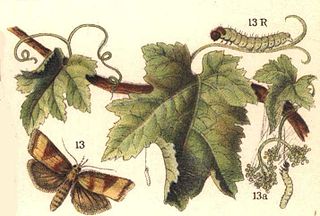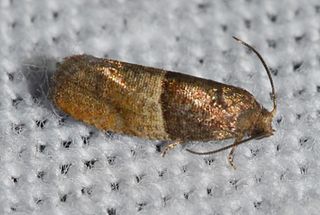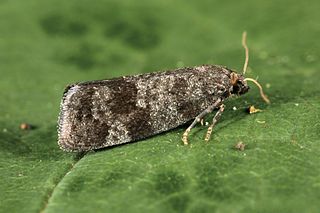Related Research Articles

Cetonia aurata, called the rose chafer or the green rose chafer, is a beetle, 20 millimetres long, that has a metallic structurally coloured green and a distinct V-shaped scutellum. The scutellum is the small V-shaped area between the wing cases; it may show several small, irregular, white lines and marks. The underside of the beetle has a coppery colour, and its upper side is sometimes bronze, copper, violet, blue/black, or grey.

The Tortricidae are a family of moths, commonly known as tortrix moths or leafroller moths, in the order Lepidoptera. This large family has over 11,000 species described, and is the sole member of the superfamily Tortricoidea, although the genus Heliocosma is sometimes placed within this superfamily. Many of these are economically important pests. Olethreutidae is a junior synonym. The typical resting posture is with the wings folded back, producing a rather rounded profile.

The punctate flower chafer or spotted flower chafer, Neorrhina punctata, is a species of flower chafer. The chafers are beetles of subfamily Cetoniinae in the large scarab beetle family (Scarabaeidae). Among the chafers, N. punctatum belongs to the tribe Schizorhinini.

The Tortricinae are the nominate subfamily of tortrix moths. Commonly referred to as leafrollers, as the larvae build shelters by folding or rolling leaves of the food plant, the tortricinae include several notable pests as well species used as biological control agents against invasive weeds.

The Sparganothini are a tribe of tortrix moths.

The Archipini are a tribe of tortrix moths. Since many genera of these are not yet assigned to tribes, the genus list presented here is provisional.

Chlidanotinae is a subfamily of moths in the family Tortricidae.

The Cochylini are a tribe of tortrix moths. It used to be classified as the subfamily Cochylinae.

Cetonia is a genus of beetles in family Scarabaeidae. One of the most familiar species is the rose chafer.

Larisa is a genus of moths belonging to the subfamily Olethreutinae of the family Tortricidae. It contains only one species, Larisa subsolana, which is found in North America, where it has been recorded from Alabama, Florida, Georgia, Illinois, Indiana, Kentucky, Maine, Maryland, Massachusetts, Minnesota, Mississippi, Missouri, New York, Ohio, Oklahoma, Ontario, Quebec, South Carolina, Tennessee, Texas, Virginia, and West Virginia.

Neosphaleroptera is a genus of moths belonging to the subfamily Tortricinae of the family Tortricidae. It contains only one species, Neosphaleroptera nubilana, which is found in almost all of Europe and the Near East.

Eugnosta is a genus of moths belonging to the family Tortricidae.

The Euliini are a tribe of tortrix moths.

Acleris ferrugana is a species of moth of the family Tortricidae. It is found in China, most of Europe and has also been recorded from North America.
Alexey Nikolaievich Diakonoff, also transliterated as Alexej Nikolajewitsch Diakonoff, was a Russian–Dutch entomologist who specialised in Microlepidoptera.
Chamaepsichia is a genus of moths belonging to the family Tortricidae.
Chamaepsichia durranti is a species of moth of the family Tortricidae. It is found in Brazil.
Chamaepsichia rubrochroa is a species of moth of the family Tortricidae. It is found in Bolivia.
Chamaepsichia chitonregis is a species of moth of the family Tortricidae. It is found in Venezuela.
Cetonia elegans may refer to: